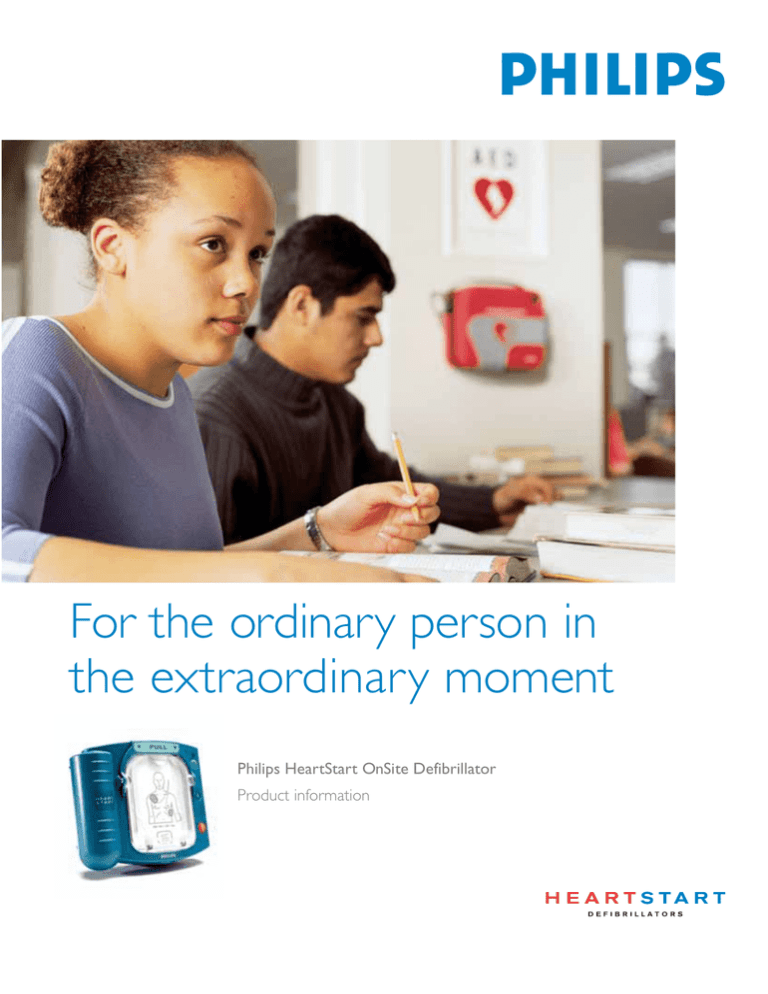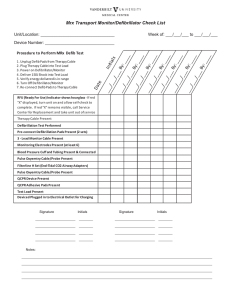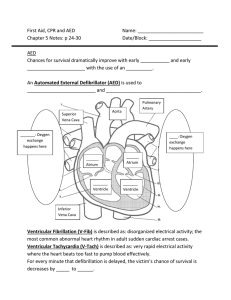
For the ordinary person in
the extraordinary moment
Philips HeartStart OnSite Defibrillator
Product information
Sudden cardiac arrest can
anyone,
2
happen to
anytime, anywhere.
• The current national survival rate
for SCA is less than 5%.
• The likelihood of successful
resuscitation decreases by about
10% with every minute that passes.
• An additional 40,000 lives could
be saved each year in the U.S.
alone with widespread access
to defibrillators.
Power to save a life
Each year sudden cardiac arrest (SCA)
strikes approximately 340,000 people
in the U.S. alone.The majority of these
people have no warning, since they
show no prior symptoms. And sadly,
fewer than 5% survive, often because
emergency medical services cannot
reach them in time.
SCA most often occurs when
the electrical system of the hear t
becomes chaotic, causing it to
stop beating effectively. Lacking
proper blood flow, the person loses
consciousness, stops breathing, and
will die unless promptly treated. CPR
is impor tant, but it alone cannot
restore a normal hear t rhythm. A
“shock” from a defibrillator is the
most effective way to restore the
hear t’s normal pumping rhythm.
The victim’s best chance of survival
is to receive that shock within
5 minutes of collapse.
Just as seat belts or airbags do not
save every life in a traffic accident,
a defibrillator will not save every
person who suffers a sudden cardiac
arrest.Yet many lives could be saved
if more people could be reached
more quickly.
Philips Hear tStar t Defibrillators
enable vir tually anyone to treat the
most common cause of SCA quickly
and effectively, wherever it happens
— at work, at play, in the air —
providing the power to save a life.
3
The Philips HeartStart
OnSite Defibrillator
Philips, the leader in por table defibrillation
technology,1 designed the Hear tStar t OnSite
Defibrillator for the ordinary person in the
extraordinary moment. Available without a
prescription, the OnSite is designed to be the
easiest to use and most reliable defibrillator
available.2,3 Our innovative technology, based
on extensive research and user feedback, has
produced a defibrillator so easy to use that
you can potentially save the life of a co-worker,
friend, or anyone else stricken with sudden
cardiac arrest.
4
Weighing just 3.3 lbs., this small and lightweight
defibrillator can be easily carried to the victim’s
side. Using clear, calm voice instructions, the
OnSite Defibrillator guides you through each
step of defibrillation, including CPR Coaching.
Integrated SMART Pads placed on the victim’s
bare skin transmit information to the defibrillator,
which senses and adapts to your actions every
step of the way.
Hear tStar t OnSite includes proven Philips
technologies for hear t rhythm assessment
(SMART Analysis) and defibrillation energy
delivery (SMART Biphasic). And like all
Hear tStar t Defibrillators, it can be used to
treat adults, as well as infants and children.4
The first defibrillator
available without a prescription
to commercial users
Ready when needed
The OnSite has a long life battery:
• 5 year shelf life plus 4 year installed life
• The same battery technology used with confidence in millions
of cameras
Automatic self-tests help ensure continued readiness:
• Daily self-tests check electrical components, subsystems and battery
• A self-test also verifies that the pads cartridge is installed
and in working order
• A blinking green “Ready” light means the OnSite has passed its last
self test, so you can be confident the defibrillator is ready for use
Easy to use
Using the HeartStart OnSite Defibrillator is simple. Pulling the
green handle activates the defibrillator and voice instructions.These
instructions are paced to your actions, to help guide you through the
entire process — from placing each pad on the patient to delivering
a defibrillation shock.
HeartStart OnSite determines if a heart rhythm
is shockable.
• If a shock is indicated, the defibrillator directs you
to press the flashing orange “Shock” button. Then
Hear tStar t OnSite delivers a dose of low-energy
biphasic therapy, a highly-effective defibrillation
waveform that is also gentle to the hear t.
Hear tStar t OnSite also reminds you to call
emergency medical services (EMS). And should EMS
need a summary of care, it can be retrieved from the
defibrillator’s internal memory. An EMS provider
simply presses the “i-button” and Hear tStar t OnSite
verbally recounts events from its last clinical use.
• If a shock is not indicated, the OnSite Defibrillator
instructs you to assess the patient and to perform
CPR if necessary. While performing CPR, the
defibrillator’s voice instructions can be activated
to coach you on the frequency and depth of
compressions.
5
Replaceable SMART Pads Cartridges
The car tridge contains two adhesive pads that are placed
on the patient’s bare skin as indicated by the pictures on
the pads.The pads are smar t because they sense when
they have been removed from the car tridge and when
each has been applied to the patient, adjusting the voice
instructions to your pace.
The Hear tStar t OnSite can be used on patients of any
age, including infants and children. OnSite senses when
the special infant/child SMART Pads Car tridge is installed.
It automatically adjusts to use a lower energy level more
appropriate for infants and children, and also provides
coaching for performing infant/child CPR.
To practice your skills, a special training pads cartridge
(adult or infant/child) can be installed in the defibrillator.
It suspends the defibrillator’s ability to shock, while
walking you through patient care scenarios.
Designed to help save a life in
extraordinary circumstances
Lightweight
Just 3.3 lbs fully equipped.
Intuitive
Clean design and clear voice instructions,
including CPR Coaching, instill the confidence
that’s needed when treating a person in
cardiac arrest.
Versatile
Available for use on anyone of any age,
including children and infants.
6
Effective
Patented SMART Analysis heart rhythm
assessment and SMART Biphasic defibrillation
therapy, clinically proven in nearly 10 years
of use. No other biphasic waveform is as well
documented. And with patented Quick Shock,
the OnSite is fastest in class at delivering
a shock after CPR. Studies show that
minimizing time to shock after CPR may
improve survival.5,6,7,8,9
Philips HeartStart OnSite Defibrillator
Product specifications
Defibrillator
Battery (M5070A)
Defibrillator Model
HeartStart M5066A
Defibrillator Family
HS1
Type
9 Volt DC, 4.2 Ah, composed of disposable long-life
lithium manganese dioxide primary cells.
How Supplied
Defibrillator, Owner’s Manual, battery, 1 adult SMART
Pads cartridge, Quick Reference Guide, Quick Start
poster, and your choice of carry case.
Capacity
Minimum 200 shocks or 4 hours of operating time.
Install-By Date
Battery is labeled with an install-by date of at least five
years from date of manufacture.
Waveform
Truncated Exponential Biphasic.Waveform parameters
adjusted as a function of each patient’s impedance.
Standby Life
Energy
Single energy output. Adult: nominal 150 Joules into a
50 ohm load. Infant/Child: nominal 50 Joules into a 50
ohm load. Automatically set based on type of SMART
Pads cartridge installed.
Four years typical when battery is installed by the
install-by date. (Will power the AED in standby state
within the specified standby temperature range,
assuming one battery insertion test and no
defibrillation uses.)
Shock-to-Shock
Cycle Time
Typically less than 20 seconds between shocks
in a series.
Quick Shock
Able to deliver a shock after the CPR pause, typically in
8 seconds.
Voice Instructions
Detailed voice messages guide responder through use
of the defibrillator.
CPR Coaching
Instructions for adult and infant/child CPR available at
user’s option.
Shock Delivery
Via adhesive pads placed on patient’s bare skin as
illustrated on pads.
Controls
Green SMART Pads Cartridge handle, green on/off
button, blue i-button, orange shock button.
Indicators
Ready light; blue i-button; caution light.
SMART Pads
Adult SMART
Pads Cartridge
M5071A defibrillation pads for patients 8 years of age
and older or 55 lbs. (25 kg) and over.
Infant/Child SMART
Pads Cartridge
M5072A defibrillation pads for patients under 8 years
of age or 55 lbs. (25 kg). Rx only.
Energy Delivered
Adult: nominal 150 Joules into a 50 ohm load.
Infant/Child: nominal 50 Joules into a 50 ohm load.
How Supplied
Disposable cartridge, containing adhesive
defibrillation pads, clicks into defibrillator for an
integrated pads solution.
Active Surface Area
13.2 in2 (85 cm2) each
Cable Length
Adult pads: 54 in (137.1 cm)Infant/Child pads: 40 in
(101.6 cm)
Use-By Date
Cartridge is labeled with a use-by date of at least two
years from date of manufacture.
Physical Specifications
Size
2.8 x 7.4 x 8.3 inches (7 x 19 x 21 cm) H x D x W
Weight
With battery and pads case: 3.3 lbs. (1.5 kg)
Without battery or pads case: 2.4 lbs. (1 kg)
Environmental/Physical Requirements
Sealing
Solid objects per EN60529 class IP2X.
Drip-proof per EN60529 class IPX1.
Temperature
Operating: 32º - 122º F (0º- 50º C)
Standby: 50º - 109º F (10º- 43º C)
Humidity
Operating: 0% to 95% relative, non-condensing
Standby: 0% to 75% relative, non-condensing
Altitude
Operating: 0 to 15,000 feet
Standby: 0 to 8,500 feet > 48 hours and 8,500 to
15,000 feet < 48 hours
Shock/Drop Abuse
Withstands 1 meter drop to any edge,
corner or surface.
Vibration
Meets EN1789 random and swept sine, road ambulance
specification in operating and standby states.
EMI (Radiated/Immunity)
Meets EN55011 Group 1 Level B Class B and
EN61000-4-3.
Patient Analysis System
Patient Analysis
Evaluates patient ECG to determine if a rhythm is
shockable. Rhythms considered shockable are
ventricular fibrillation (VF) and certain ventricular
tachycardias (VT) associated with lack of circulation.
For safety reasons, some VT rhythms associated with
circulation will not be interpreted as shockable, and
some very low-amplitude or low-frequency rhythms
will not be interpreted as shockable VF.
Sensitivity/Specificity
Meets AAMI DF80 guidelines and AHA
recommendations for adult defibrillation (Circulation
1997;95:1677-1682).
Artifact Detection
The effects of pacemaker artifact and electrical noise
are minimized with artifact detection.
Training Pads
Adult Training Pads
Cartridge
M5073A
Infant/Child Training
Pads Cartridge
M5074A
Function
Special pads put HeartStart OnSite into training mode
and disable its energy delivery capability.Training pads
feature 8 real-world training scripts. Used with training
mat (included) or with adapters on manikins.
Automated and User-Activated Self-Tests
Daily Automatic Self-tests
Tests internal circuitry, waveform delivery system, pads
cartridge and battery capacity.
Pads Integrity Test
Specifically tests readiness-for-use of pads
(gel moisture).
Battery Insertion Test
Upon battery insertion, extensive automatic self-tests
and user-interactive test check device readiness.
Status Indicator
Blinking green “Ready” light indicates ready for use.
Audible “chirp” indicates need for maintenance.
Data and Recording and Transmission
Infrared
Wireless transmission of event data to personal
computer using the IrDA protocol.
Data Stored
First 15 minutes of ECG and the entire incident’s events
and analysis decisions.
* Refer to HeartStart OnSite Defibrillator Owner’s Manual for detailed product instructions. All specifications
based on 25º C unless otherwise noted.The defibrillator and its accessories are made of latex-free materials.
7
Philips — The trusted choice
• One of the world’s largest medical products companies with annual
revenue of over $6 billion
• History of innovation. Philips introduced the medical X-ray tube in
1 1918, the audiocassette in 1963, the first VCR and created compact
disc technology
• With over 200,000 automated external defibrillators installed, Philips
has more AEDs on the job, in the air, in the classroom and in your
neighborhood than anyone else1
• Over 4.5 billion HeartStart Defibrillator service hours logged, with an
additional 2.7 million hours added every day
• Over 17% of Fortune 1000 companies, 8 out of 10 major airlines and
43 professional sports teams rely on Philips HeartStart Defibrillators
The Hear tStar t OnSite Defibrillator is the first defibrillator for
commercial and institutional users without a prescription. As the
leader in innovative defibrillation technology,1 Philips is committed to
making defibrillators more widely available so that more lives
Philips Medical Systems is part
of Royal Philips Electronics
On the Web
www.philips.com/heartstart
Via email
medical@philips.com
By fax
+31 40 27 64 887
By postal service
Philips Medical Systems
3000 Minuteman Road
Andover, MA 01810-1085
Asia
Tel: +852 2821 5888
Europe, Middle East and Africa
Tel: +31 40 27 63005
can be saved. Now with over-the-counter status, Philips is making
it easier for companies and organizations to institute early
Latin America
defibrillation programs.
North America
Tel: +55 11 2125 0764
Tel: +1 800 934 7372
Defibrillators are one par t of a well-planned resuscitation program.
Philips recommends medical oversight of your early defibrillation
program by a physician or other authorized medical practitioner.
Consult your state and local requirements regarding owning and
operating defibrillators, and medical oversight.
To learn more about the HeartStart OnSite Defibrillator and Philips
Medical Systems, visit www.philips.com/heartstart or call 800.934.7372.
References
Frost & Sullivan
Andre, et al.Automated External Defibrillator Use by Untrained Bystanders: Can the Public-use Model Work? Prehospital Emergency Care 2004;8:284-291
3
Snyder,Time to Shock vs Voice Prompt Duration: Optimization of Defibrillators for Public Access and Home Deployment. 6th Scientific Congress of
the European Resuscitation Council, Oct 2002
4
The Infant/Child pads cartridge is sold separately, and available only under the order of a physician.
5
Yu et al.Adverse Outcomes of Interrupted Precordial Compression During Automated Defibrillation. Circulation 2002; 106:368-372.
6
Eftesol T, Sunde K, Steen PA. Effects of Interrupting Precordial Compressions in the Calculated Probability of Defibrillation Success During Out-ofHospital Cardiac Arrest. Circulation 2002; 105:2270-2273.
7
Snyder et al. Biphasic Defibrillation Waveform Combined with AED-Imposed “Hands-Off” Intervals Significantly Affect Outcome Following Prolonged
Cardiac Arrest.Abstract from 7th Scientific Congress of the European Council, 2004
8
Snyder & Morgan. CPR Interruption Interval Varies Widely Among Commercially Available AEDs.Abstract from 7th Scientific Congress of the European
Council, 2004
9
Snyder, D.E. and Morgan, C.Wide Variations in Cardiopulonary Resuscitation Intervals Among Commercially Available Automated External
Defibrillators May Affect Survival Despite High Defibrillation Efficacy. Critical Care Medicine. 2004;32(9) Supplement:S421-S424
1
2
© Koninklijke Philips Electronics N.V. 2005 All rights reserved.
Reproduction in whole or in part is prohibited without the prior
written consent of the copyright holder.
Philips Medical Systems North America Corporation reserves
the right to make changes in specifications or to discontinue any
product at any time without notice or obligation and will not be
liable for any consequences resulting from the use of this publication.
Printed in the U.S.
452297700761 * 2005-02





